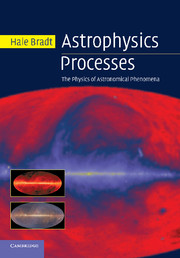Book contents
- Frontmatter
- Contents
- List of figures
- List of tables
- Preface
- Acknowledgments
- Also by the author
- 1 Kepler, Newton, and the mass function
- 2 Equilibrium in stars
- 3 Equations of state
- 4 Stellar structure and evolution
- 5 Thermal bremsstrahlung radiation
- 6 Blackbody radiation
- 7 Special theory of relativity in astronomy
- 8 Synchrotron radiation
- 9 Compton scattering
- 10 Hydrogen spin-flip radiation
- 11 Dispersion and Faraday rotation
- 12 Gravitational lensing
- Credits, further reading, and references
- Glossary
- Appendix: Units, symbols, and values
- Index
4 - Stellar structure and evolution
Published online by Cambridge University Press: 05 June 2012
- Frontmatter
- Contents
- List of figures
- List of tables
- Preface
- Acknowledgments
- Also by the author
- 1 Kepler, Newton, and the mass function
- 2 Equilibrium in stars
- 3 Equations of state
- 4 Stellar structure and evolution
- 5 Thermal bremsstrahlung radiation
- 6 Blackbody radiation
- 7 Special theory of relativity in astronomy
- 8 Synchrotron radiation
- 9 Compton scattering
- 10 Hydrogen spin-flip radiation
- 11 Dispersion and Faraday rotation
- 12 Gravitational lensing
- Credits, further reading, and references
- Glossary
- Appendix: Units, symbols, and values
- Index
Summary
What we learn in this chapter
The structure of a star may be modeled with the aid of the four fundamental equations of stellar structure – namely, mass and luminosity distributions, hydrostatic equilibrium and radiative (or convective) transport – together with the equation of state (EOS) and several secondary equations. Each of these describes some essential applicable physics that must be obeyed at each point of the stellar interior. Given a stellar mass and elemental composition, these equations can be used to create a model of a star that yields the radial distribution of mass density, pressure, temperature, and luminosity within the star. The adiabatic constraint leads to a condition for convective energy transport in stars.
Hydrogen-burning stars of different masses lie along the main sequence on a Hertzsprung–Russell (H-R) diagram, which is a plot of luminosity versus temperature. Stars of high mass burn their hydrogen rapidly, in millions of years, whereas stars of low mass can burn hydrogen stably for billions of years. After leaving the main sequence, a star becomes a red giant or a supergiant and eventually evolves to become a white dwarf, neutron star, or black hole. A group of stars created together from a single collapsing cloud at a given time is known as a globular cluster or an open cluster. H-R diagrams of cluster stars dramatically exhibit the differing ages of clusters and the results of stellar evolution.
Information
- Type
- Chapter
- Information
- Astrophysics ProcessesThe Physics of Astronomical Phenomena, pp. 117 - 180Publisher: Cambridge University PressPrint publication year: 2008
